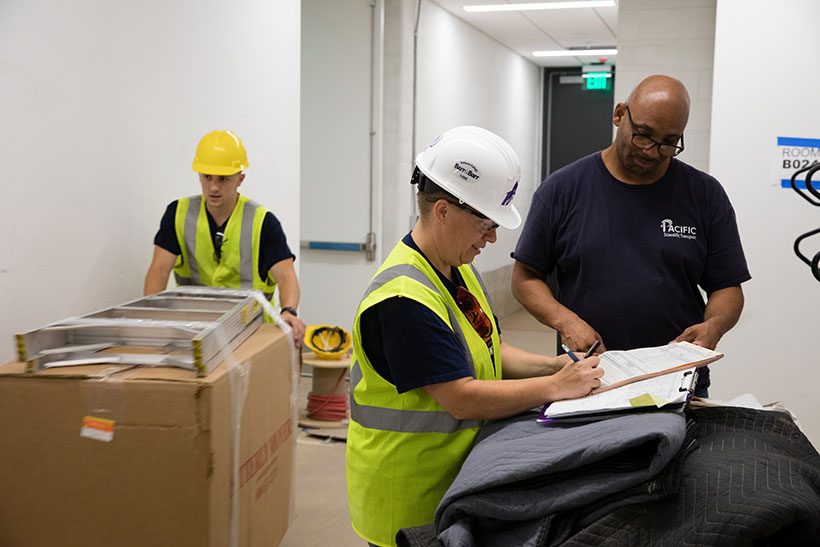
Jess Martin is having a busy day. The administrative director of the new Science Center nurses a cup of coffee adorned with the words “She who must be obeyed” and scrolls quickly on her computer. It’s 9 a.m. and she’s working her way through a pile of email. There is less than week before the grand opening of the Science Center and there’s a lot left to do.
“Tell me anything that’s a crisis,” she says to Anders Griffen, the Science Center program coordinator. Around them in the building’s living room, with its colorful rugs and soft furniture, people talk and study. Through the wall of windows beyond, which Martin likes to call the “weather on IMAX,” students hurry to class in the rain.
The day has brought unexpected problems. A lock has been removed from a door in the now-closed Merrill Science Center and needs to be reinstalled. A room full of aquariums of fish has water on the floor.
Martin has already spent part of her morning shepherding equipment from the old Merrill greenhouse to the one at the new Science Center. Before her day is through, she will work through an impressive list of five meetings, multiple check-ins, an interview with The Chronicle of Higher Education and an hour of open office time.
It’s a normal day for Martin, who uses a notebook covered with Mammoth stickers to keep track of a dizzying array of details and meetings. Hired in 2016 as a new addition to the Office of the Dean of the Faculty—and fresh off of a stint as program director for the Niels Bohr Institute at the University of Copenhagen—Martin was charged with coordinating the transition from Amherst’s old science center to the new one. Now that the move is mostly complete, Martin’s charge is to help relieve the administrative burden from the science faculty and help mold the seven science departments into a single cohesive cohort.
“I’m a matchmaker,” she jokes. “I bring people together.”
To do that, Martin is part landlord and part entertainment director for a giant cruise ship of science. In her office, Martin has a mascot named Keith, a giant brain coral that a faculty member gave her. She is prone to wearing shirts with mottos like “Never trust an atom—they make up everything” and “Actually, it IS rocket science.” To introduce students and faculty to the building, Martin has run treasure hunts with 15 tiny mammoths hidden all over the Science Center.

Most of her humor is of the merry-prankster variety, but Martin also has a deep dry streak. When the wrong electrical sockets were installed, Martin needed a way to tell workers where to install the correct “standby lab power” versions. So she tacked up a bunch of bright pink signs that said simply, “SBLABP it!”
“Once you confront a horrible thing, in my world it’s mission impossible: make it as joyful as possible,” she says.
In the Science Center living room, Martin has started Friday afternoon gatherings where she encourages students to hold court about their extracurricular groups, such as women in science or the electronics club. She’s also asked faculty to bring musical instruments and take advantage of the resounding acoustics in the space. For the first of these jam sessions, Martin brought her guitar and performed “What’s Up?” by 4 Non Blondes.
“It really is a nice way to end the week to have these community events, so I’m making it a priority,” Martin says. “I like to end my week on a high note.”
On this particular Thursday, Martin has wrapped up meetings with Griffen and Pat Allen, director of campaign events, and is headed to a meeting with physics professor David Hall ’91, where the two will decide what experiments students might perform during the Science Center’s grand opening event on October 20.
On the way, Martin passes a section of the living room where people have moved footstools over to the windows, forming a pattern of colorful objects. She seems heartened by this.
“I like to see a little subversion and spontaneity,” she says. “It’s great to see how people are adapting to the space as though it was always here.”